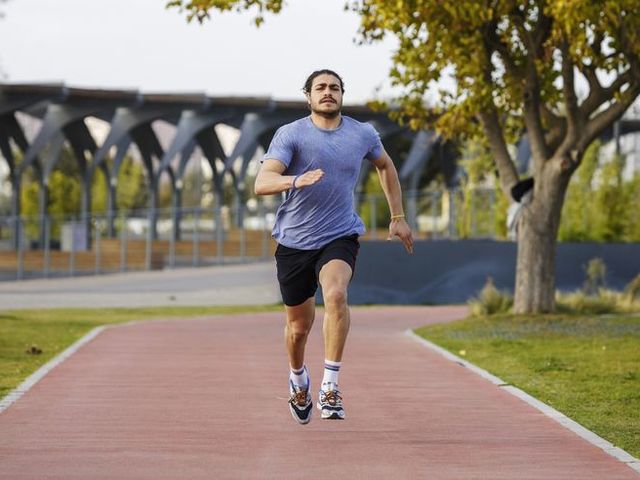You want to get faster. Who doesn’t? But in order to supercharge your sprints, you need to get the basics down first. Sprinting is about more than just being fast. Here, we’ll break down all you need to know for how to sprint faster. Spoiler: It all comes down to your form.
How to Sprint Faster
One of the main factors for speed is form. Sprinting isn’t exactly just a sped-up version of your regular running form during an easy run. It’s similar, but different: The movement patterns of running and sprinting are similar in that you still need to put one foot in front of the other, but different in that sprinting is a much more dynamic version of running—more explosive, to be precise.
If you compared them on a continuum, walking and easy jogging would be on the left side, while sprinting would be on the far right. Think of it like this: walking to jogging to running to fast running to sprinting. All will get you from point A to B, but sprinting requires more power and muscle activation to cover the same stretch of road.
Another difference between jogging, running, and sprinting is foot strike. When walking, jogging, and running, most runners land with a heel strike. The faster you run, the more you shift from heel strike to midfoot to a forefoot landing.
If you want to get faster at sprinting, the key is to nail down the basics. Follow these nine steps to speed up your sprints.
1. Warm Up
The harder you run, the more vital it is to warm up your muscles. Walk and easy run for a minimum of five to 10 minutes, and include dynamic exercises or drills such as high knees, butt kicks, and skipping to further prepare your body to run fast. Try this 5-minute warmup routine to open up and stretch your hips, quads, hamstrings, and back.
2. Focus on Posture and Core
Keep your torso upright, shoulders relaxed and away from your ears, and engage your core (don’t collapse). Unleash your proud pose, chest lifted, and tilt forward. You should also try to incorporate core-strengthening moves—think: side plank with reach, legs down with scissors, and mountain climbers—into your workouts to help give you the power to push forward.
3. Think Circular
Train yourself to think like a cyclist and move your feet in a circular motion, raising your thighs up until they are parallel to the ground, and driving your knees up and down. Think about the motion your feet make as being round like a circle, rather than an oval or a reaching-out, “pawing” motion.
4. Land Efficiently
Aim to land on your forefoot, and focus on pushing off from your toes to propel yourself forward and keeping your feet flexed upward toward your shins. Running softer and landing quieter may help reduce injury, too, research shows.
5. Drive Your Arms
Hold your arms in a bent position at 90 degrees, and drive your elbows straight backward to create momentum. The position helps ensure that your movement and force travel in the same direction.
It’s a more exaggerated arm swing than a jog. Move your arms through a wider range of motion with your hands coming up as high as your chin and backward toward your butt. But try to avoid letting your arms cross the centerline of your body. Everyone’s natural mechanics are different, but doing so will cause rotation in your torso, which leads to inefficient running.
6. Shorten Your Stride
Long strides are energy wasters—you end up producing more vertical energy and projecting more upward motion than forward motion. Focus on cadence speed rather than distance as you sprint. You’ll run faster and more efficiently by taking short, super quick strides.
7. Kick Your Butt
As you push off from your forefoot and toes, bring your heels up all the way up toward your butt before pulling your knee forward, swinging your leg out, and landing again. Doing so will help engage more muscles in your legs and glutes for a more powerful stride
8. Breathe
Relaxing into the running pattern and syncing your breath to the rhythm of your feet will reduce wasted energy from muscle tension. Follow these tips to improve your breathing while you run to help prevent injury.
9. Perform Rolling Starts
Try this drill to feel the difference between walking, jogging, running, and sprinting. Start by walking, and increase your speed every 10 seconds until you reach a sprinting speed.
As with any high-intensity workout, a little goes a long way. Work into high-intensity sprint training gradually to allow your body to adapt to the demands of the workout, and stick with it to see improvements in your running fitness and overall health.


























